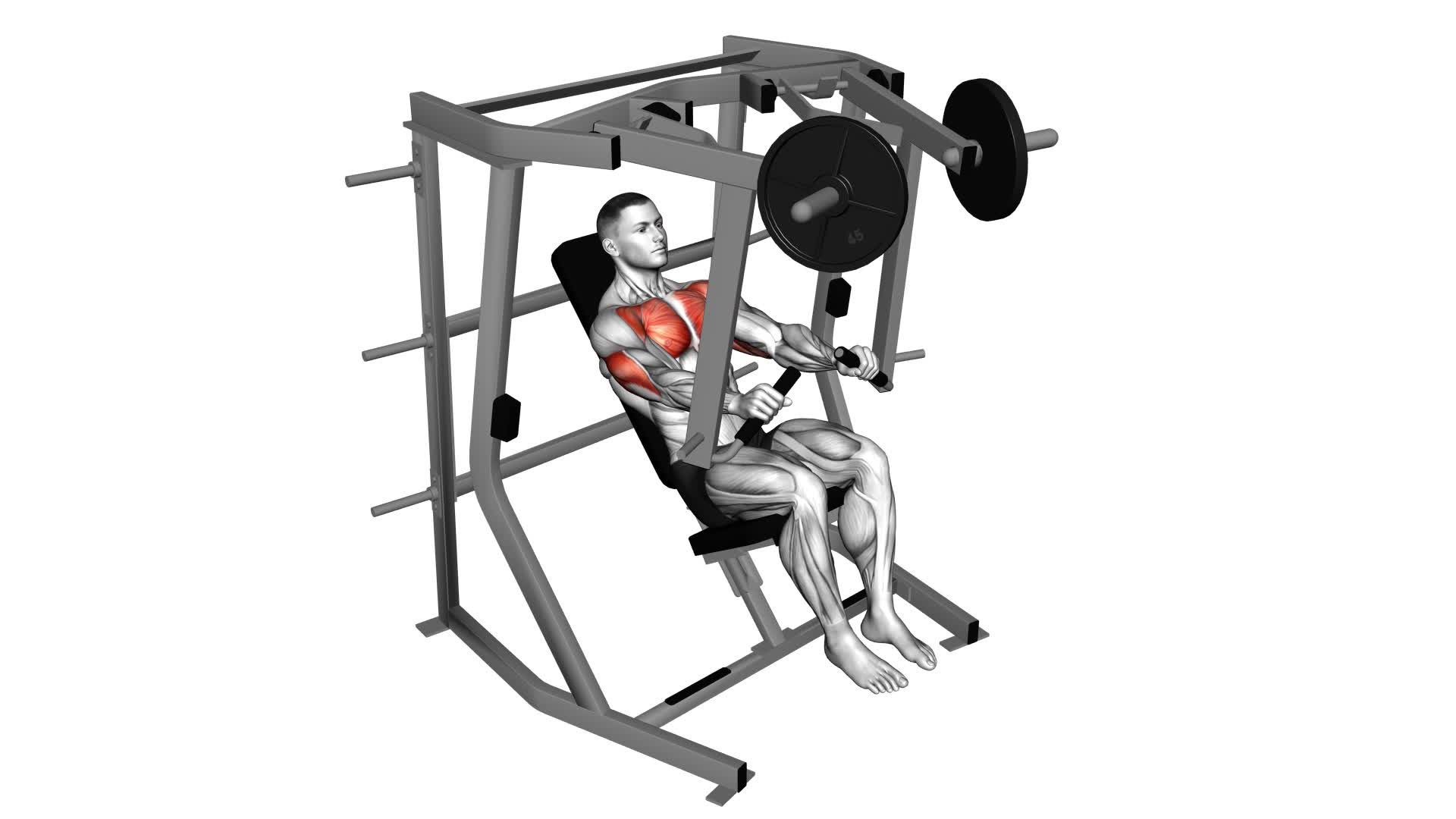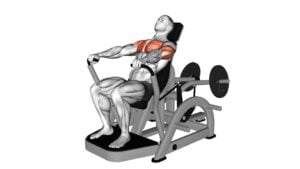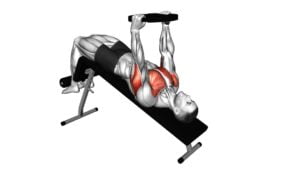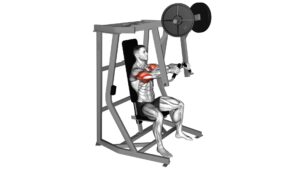Lever Decline Chest Press – Video Exercise Guide & Tips

Are you looking to strengthen your chest muscles with an effective exercise? Look no further than the Lever Decline Chest Press!
Watch This Exercise Video
This video exercise guide and tips will show you the proper technique and form for maximum results. Set up your equipment correctly, follow the step-by-step guide, and avoid common mistakes to get the most out of this exercise.
Increase intensity and progression with helpful tips and stay safe with modifications for beginners.
Let's get started!
Key Takeaways
- Targets pectoralis major and minor
- Engages lower chest muscles effectively
- Activates anterior deltoids, triceps, and core muscles
- Builds strength and muscle mass in the chest
Benefits of the Lever Decline Chest Press
You will frequently experience the benefits of the Lever Decline Chest Press. This exercise primarily targets your chest muscles, specifically the pectoralis major and minor. By using a decline bench, you increase the range of motion and engage your lower chest muscles more effectively. The Lever Decline Chest Press also activates your anterior deltoids, triceps, and core muscles, providing a full upper body workout.
One of the key benefits of this exercise is its ability to build strength and muscle mass in your chest. As you push the lever handles away from your body, you're able to lift heavier weights compared to traditional chest press exercises. This increased resistance stimulates muscle growth and helps you develop a more defined and powerful chest.
Another advantage of the Lever Decline Chest Press is its versatility. You can vary the position of the bench to target different areas of your chest. For example, setting the bench at a steeper decline angle will emphasize the lower chest muscles, while a shallower decline angle will emphasize the middle chest muscles. By adjusting the bench angle, you can customize your workout to suit your specific goals.
In addition to building strength and muscle mass, the Lever Decline Chest Press also improves your functional fitness. It mimics pushing movements that you perform in everyday activities, such as pushing heavy objects or pushing yourself up from a lying position. By regularly incorporating this exercise into your routine, you'll enhance your upper body strength and improve your overall physical performance.
Proper Equipment Setup for the Exercise
To properly set up the equipment for the Lever Decline Chest Press:
- Position yourself on a decline bench with your feet securely anchored and the lever handles within comfortable reach. The decline bench should be set at an angle that allows for a challenging workout while maintaining proper form.
- Make sure the bench is stable and secure to prevent any accidents or injuries during the exercise.
Before starting the exercise:
- Adjust the lever handles to your desired height. The handles should be at a level that allows your arms to extend fully without any strain. This will ensure that you're able to perform the exercise with proper technique and maximize the benefits.
- Additionally, ensure that the decline bench is positioned in a way that allows you to comfortably lie back and maintain a stable position throughout the exercise. Your feet should be firmly planted on the ground, and your body should be aligned from head to toe.
Step-by-Step Guide to Performing the Exercise
To begin the Lever Decline Chest Press exercise, position yourself on the decline bench with your feet securely anchored and the lever handles within comfortable reach. Make sure the bench is set at an angle that targets the lower portion of your chest muscles. This exercise primarily targets the pectoralis major, triceps, and deltoids. It's a great variation of the chest press exercise that offers unique benefits.
Before starting the exercise, ensure that your back is firmly pressed against the bench and your core is engaged. This will help maintain stability and prevent any unnecessary strain on your lower back. Grab the lever handles with an overhand grip, slightly wider than shoulder-width apart. This grip will allow you to maintain control and stability throughout the movement.
As you exhale, push the levers forward and extend your arms fully while keeping your elbows slightly bent. Be sure to maintain control and avoid locking out your elbows. Inhale as you slowly bring the levers back, allowing your elbows to bend and your chest muscles to stretch.
Common Mistakes to Avoid
When performing the lever decline chest press, it's important to be aware of common mistakes that can hinder your progress.
One common mistake is incorrect arm positioning, such as flaring your elbows out too wide or tucking them in too close to your body.
Another mistake to avoid is improper weight selection, as using weights that are too heavy or too light can affect your form and overall effectiveness of the exercise.
Lastly, lack of proper form, such as arching your back or not fully extending your arms, can also hinder your results.
Incorrect Arm Positioning
Ensure that your arms are properly positioned before starting the lever decline chest press exercise. Improper arm placement can increase the risk of potential shoulder injury. Here are some common mistakes to avoid:
- Shoulders too far forward: Placing your shoulders too far forward can put excessive strain on the front of your shoulder joints, increasing the risk of injury.
- Elbows flared out: Allowing your elbows to flare out to the sides can lead to unnecessary stress on the shoulder joints, potentially causing discomfort or injury.
- Arms too far apart: Keeping your arms too far apart can compromise your stability and decrease the effectiveness of the exercise, while also increasing the risk of shoulder strain.
- Inward or outward rotation: Avoid rotating your arms inward or outward during the exercise, as this can place excessive stress on the shoulder joint and lead to injury.
Improper Weight Selection
To avoid common mistakes and ensure optimal results, it's important for you to select the appropriate weight when performing the lever decline chest press exercise. Proper weight selection is crucial to avoid injury and maximize the effectiveness of your workout. Here are some weight selection tips to help you make the right choice.
First, start with a weight that challenges you but still allows you to maintain proper form throughout the exercise. If the weight is too heavy, you may compromise your technique and increase the risk of injury. On the other hand, if the weight is too light, you won't be effectively targeting your chest muscles.
Additionally, consider your fitness level and goals. Beginners should start with lighter weights and gradually increase the resistance as they gain strength. Advanced lifters may need to use heavier weights to continue challenging their muscles.
Remember to listen to your body and adjust the weight accordingly. If you experience pain or discomfort, decrease the weight or seek guidance from a fitness professional.
Lack of Proper Form
Avoid using incorrect form while performing the lever decline chest press exercise to maximize its effectiveness and prevent injury. Proper technique is crucial for getting the most out of this exercise and avoiding strain on your muscles and joints. Here are some common mistakes to avoid:
- Arching your back: Keep your back flat against the bench throughout the movement to maintain stability and engage your chest muscles effectively.
- Flaring your elbows: Keep your elbows tucked in close to your body to target your chest muscles and avoid unnecessary stress on your shoulders.
- Using momentum: Control the movement and avoid using momentum to lift the weight. This ensures that your muscles are doing the work and prevents injury.
- Not fully extending your arms: Make sure to fully extend your arms at the top of the movement to engage your chest muscles fully and prevent imbalances.
Tips for Increasing Intensity and Progression
To increase the intensity and progression of your lever decline chest press, incorporate these effective tips.
- First, focus on increasing resistance. This can be done by using heavier weights or resistance bands. Gradually increase the weight or resistance as you get stronger to continually challenge your muscles.
- Another way to increase intensity is by incorporating advanced modifications. For example, you can perform a single-arm lever decline chest press, which requires more stability and engages your core muscles even more. You can also try a staggered stance, where one foot is in front of the other, to challenge your balance and activate different muscles.
- Additionally, you can vary the tempo of your reps. Slow down the lowering phase and then explode during the pushing phase to engage your muscles differently and increase the difficulty of the exercise.
- Finally, make sure to listen to your body and give yourself enough time to recover between workouts. This will allow your muscles to repair and grow stronger.
Safety Precautions and Modifications for Beginners
To ensure safety during the lever decline chest press, it's important to focus on proper form. Watch the video demonstration to understand the correct technique and avoid injury.
As a beginner, gradually increase the weight used to prevent overexertion and strain.
Additionally, consider modifications that promote joint health, such as using a wider grip or reducing the range of motion.
Proper Form Demonstration
Make sure to use proper form and follow safety precautions when performing the Lever Decline Chest Press exercise, especially if you're a beginner. Here are some tips to help you demonstrate proper form and ensure your safety:
- Proper Breathing Techniques: Take a deep breath in before lowering the lever and exhale as you push it back up. This helps stabilize your core and maintain control throughout the movement.
- Muscle Activation Techniques: Engage your chest muscles by focusing on squeezing them as you push the lever away from your body. Keep your elbows slightly bent and maintain tension in your chest muscles throughout the exercise.
- Maintain a Stable Position: Keep your feet flat on the ground and your back pressed firmly against the bench. This helps provide stability and prevents any unnecessary strain on your lower back.
- Start with Light Weights: If you're a beginner, start with lighter weights to ensure that you can maintain proper form throughout the exercise. As you become more comfortable and confident, gradually increase the resistance.
Gradual Weight Progression
When progressing with weights for the Lever Decline Chest Press, beginners should start by gradually increasing the resistance to ensure safety and proper form. It's important to follow a gradual progression plan to avoid injury and allow your muscles to adapt to the increasing demands.
Begin with a weight that challenges you but still allows you to complete the exercise with good form. As you become comfortable with the weight, gradually increase it in small increments. This could mean adding 5-10 pounds every week or two, depending on your individual strength and fitness level.
Remember to listen to your body and never push yourself beyond your limits. By following a gradual weight progression, you can safely and effectively build strength and improve your performance in the Lever Decline Chest Press.
Modifications for Joint Health
For optimal joint health and to ensure safety and effectiveness, beginners should consider modifying their approach to the Lever Decline Chest Press exercise. Joint-friendly modifications and alternative exercises can help reduce the risk of injury and provide a gentler introduction to this challenging exercise. Here are some options to consider:
- Reduce the weight: Start with a lighter weight or even just your body weight to allow your joints to adapt gradually.
- Decrease the angle: Instead of using a steep decline bench, begin with a smaller decline or even perform the exercise on a flat bench.
- Use dumbbells: Instead of using a lever machine, try using dumbbells to perform a decline chest press. This allows for a greater range of motion and can be more joint-friendly.
- Incorporate stability exercises: Focus on building stability and strength in the surrounding muscles by incorporating exercises like push-ups, planks, and resistance band chest presses.
Frequently Asked Questions
What Are the Primary Muscles Targeted During the Lever Decline Chest Press?
During the lever decline chest press, the primary muscles targeted are your chest muscles, specifically the pectoralis major and minor. This exercise also engages your shoulder muscles, including the deltoids and triceps.
It's important to note that individuals with shoulder injuries should modify this exercise by using lighter weights and focusing on proper form to avoid exacerbating their condition.
Always consult with a healthcare professional before starting any new exercise routine.
How Many Sets and Repetitions Should Be Performed During This Exercise?
To get the most out of the lever decline chest press, it's important to know how many sets and repetitions to perform.
This exercise is effective for targeting your chest muscles, but it can also work your triceps and shoulders.
Incorporating proper form is crucial to avoid injury and maximize results.
Can the Lever Decline Chest Press Be Modified for Individuals With Shoulder Injuries?
If you have shoulder injuries, you may wonder if the lever decline chest press can be modified for you.
The good news is that there are modifications available to help you safely perform this exercise.
By adjusting the range of motion and using lighter weights, you can still benefit from the lever decline chest press for overall upper body strength.
These modifications can help you avoid further shoulder strain while targeting your chest muscles effectively.
Is It Necessary to Warm up Before Performing This Exercise?
It is necessary to warm up before performing the lever decline chest press.
Dynamic warm-up exercises are important before strength training to increase blood flow, loosen up muscles, and prepare your body for the workout.
Incorporating a pre-workout stretching routine also has benefits, such as improved flexibility and reduced risk of injury.
What Are Some Alternative Exercises That Can Be Done to Target the Same Muscle Groups as the Lever Decline Chest Press?
To target the same muscle groups as the lever decline chest press, you can try alternative exercises like incline dumbbell press and decline push ups. These exercises work the chest, shoulders, and triceps, just like the lever decline chest press.
Incline dumbbell press involves lying on an incline bench and pressing dumbbells up, while decline push ups are done with your feet elevated on a bench or step.
Both exercises provide a challenging workout for your upper body.
Conclusion
In conclusion, the lever decline chest press is a highly effective exercise for targeting the chest muscles. By following proper equipment setup and using the correct technique, you can maximize the benefits of this exercise. It's important to avoid common mistakes and gradually increase intensity for progression.
Beginners should take safety precautions and make modifications as needed. Incorporate the lever decline chest press into your workout routine to build a strong and defined chest.

Author
Years ago, the spark of my life’s passion ignited in my mind the moment I stepped into the local gym for the first time. The inaugural bead of perspiration, the initial endeavor, the very first surge of endorphins, and a sense of pride that washed over me post-workout marked the beginning of my deep-seated interest in strength sports, fitness, and sports nutrition. This very curiosity blossomed rapidly into a profound fascination, propelling me to earn a Master’s degree in Physical Education from the Academy of Physical Education in Krakow, followed by a Sports Manager diploma from the Jagiellonian University. My journey of growth led me to gain more specialized qualifications, such as being a certified personal trainer with a focus on sports dietetics, a lifeguard, and an instructor for wellness and corrective gymnastics. Theoretical knowledge paired seamlessly with practical experience, reinforcing my belief that the transformation of individuals under my guidance was also a reflection of my personal growth. This belief holds true even today. Each day, I strive to push the boundaries and explore new realms. These realms gently elevate me to greater heights. The unique combination of passion for my field and the continuous quest for growth fuels my drive to break new ground.



